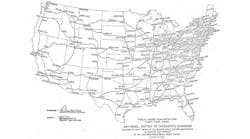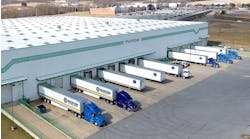Behind the driver, fuel costs are the highest costs for fleet operations. While fleets can’t control the cost of fuel, they can employ measures to help control how it’s used. While one may believe a truck’s fuel efficiency boils down to its estimated mpg rating, fuel efficiency can be—and is often—much more than that.
“I think that fuel efficiency has more to do with the technology enablement that trucking companies use,” said Ted Pardee, chief revenue officer at PCS Software, a transportation management software company. He said that, typically, “the companies that are willing to invest in technology... have the most efficiency and save the most money.”
Technology can help fleet managers and dispatchers attack inefficiencies preventing a truck from achieving its best mpg. These inefficiencies range from truck and trailer designs to specific routes. They can also include operational inefficiencies such as excessive idling, taking routes with ongoing construction, driver practices, and poor communication between the driver, manager, and customer. Each of these aspects affects fuel efficiency.
See also: Fleet costs jump 21.3%, with fuel by far the leading expense
Daniel Burrows, VP and general manager of TruckWings at ConMet, said fuel inefficiencies come from six primary factors: driver, equipment, load, traffic, terrain, and weather.
“For a fleet to really understand what is driving their current fuel economy and how they can improve it, they need an understanding of each of these factors and how they interplay,” Burrows said. “Each fleet’s answer will be different.”
Gathering this data gives fleets what Pardee called a “macro view” of each variable, and telematics software can help fleets gather this information and compile it for actionable use within the fleet to address fuel-related and operational inefficiencies.
“Those are just data points that should be feeding your TMS,” Pardee said. “They should be feeding that so that as you come to work every day, you have everything you need on your screen right in front of you.”
What affects fuel efficiency?
Equipment can affect fuel efficiency in several ways. Fleets that employ older trucks won’t benefit from newer, modern equipment with electronic systems designed to optimize performance. Additionally, equipment manufactured with lightweight components, such as aluminum or composite materials, contribute to reduced vehicle weight, which increases fuel efficiency, Burrows explained.
“The Department of Energy says reducing a vehicle’s weight by 10% can result in a 6-8% increase in fuel efficiency,” Burrows told FleetOwner.
Another way equipment can impact fuel efficiency is aerodynamic drag, which Burrows said can have a 15% fuel economy impact.
Multiple products on the market can improve a rig’s aerodynamics by closing gaps that increase wind resistance, such as aerodynamic side mirrors, trailer skirts, side fairings, and roof deflectors, Burrows said. TruckWings by ConMet is another such product that can help improve a truck’s aerodynamics with no driver impact and no additional driver training.
Weather is another factor that can impact fuel efficiency, but Burrows said it can present both challenges and advantages. Cold weather increases the time it takes for an engine to warm up, drivers are more likely to idle their engines longer to keep warm, and the higher density of cold weather creates more wind resistance, Burrows explained. Fleets will likely experience the opposite with warm weather, however, because it increases engine efficiency, its lower density produces less wind resistance, and in milder climates, drivers are less likely to idle their engines for extended periods to stay at a comfortable temperature—while APUs can even further reduce the need to idle for comfort.
But even if fleet managers do their best to eliminate these outside variables that decrease efficiency, data capture can help reveal and eliminate operational inefficiencies.
Behavior’s role in fuel efficiency
Fleet management technology can also track operational variables through a “centralized view,” including active loads, available trucks, available drivers, when a driver will timeout, equipment location, and more, Pardee told FleetOwner.
This technology also notes driver behaviors. Burrows said that it was through data capture that the TruckWings team discovered driver behaviors can affect fuel efficiency by as much as 12%, “even when assisted with best-in-class cruise controls.”
This effect on fuel economy isn’t always due to a driver’s behaviors as they’re driving a vehicle, but also how a driver plans their route, which can include taking less efficient routes, effective pre-checks, and idling, Burrows explained.
With driver shortage and retention concerns across the industry, noted in the American Transportation Research Institute’s latest survey about top industry concerns, fleet managers might be apprehensive about piling additional responsibilities onto their drivers. But drivers aren’t the only ones who affect fuel efficiency. Each fleet employee is responsible for it, Pardee told FleetOwner.
The drivers—those with eyes on the physical road—should communicate with dispatchers—often viewing roads from monitors—about whether the route has a construction zone, if an accident closed lanes, or if the driver knows of a better route. After the driver communicates with the dispatcher or manager, they should enter that data into the fleet management system to track.
Once the drivers communicate what they know, managers should use that information along with route-planning software—which considers outside factors such as weather, traffic, and road conditions—to plan more strategic, efficient routes for drivers, Burrows said. An efficient route will result in fewer unplanned stops, minimize detours, and reduce fuel consumption, Burrows told FleetOwner.
While fleet managers can work to improve fuel efficiency bit by bit, addressing multiple factors at once through data collection and analysis can help achieve those results more quickly.
“The communication between the teams is critical,” Pardee told FleetOwner. “And having that central repository that they can all work together within is how I think ultimately, fuel prices are managed, shipping prices are managed, and people start to enjoy their jobs again.”




